Zotac's Ion: The World's First mini-ITX Ion Board
by Anand Lal Shimpi on May 12, 2009 12:00 AM EST- Posted in
- GPUs
Putting It in Perspective: The Atom Takes on a Single-Core Pentium 4
When the Atom first appeared I immediately did my best to characterize its performance. Intel always referred to it as having the performance of a 90nm Pentium M but never really got as specific as I would like. In my subsequent testing I found that at 1.6GHz, Intel’s Atom performed like a 1.2GHz 90nm Pentium M (Dothan). If you had a Pentium M notebook back then, the comparison makes sense to you. If you didn’t, however, then you’d need another reference point.
I realized I had no idea how Atom compared to an old Pentium 4. To remedy the situation I dug up an old Dell based on a single-core, Northwood based (130nm) Pentium 4 running at 2.66GHz. These chips used a 533MHz FSB and had a 512KB on-die L2 cache. The system had an ATI Radeon X800 XT and 2GB of DDR memory. This Pentium 4 did not have Hyper-Threading, this was before HT made its official desktop debut.
For my first test I turned to Adobe Photoshop CS4:
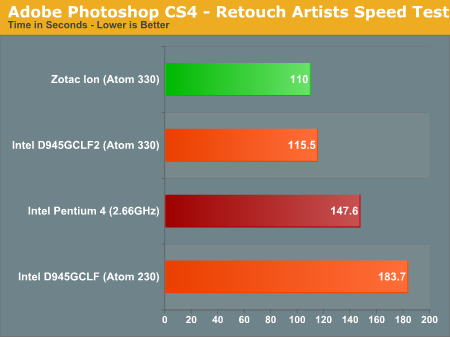
Wow. This is huge. Intel’s dual-core Atom 330 is 25% faster than the 2.66GHz Pentium 4. The advantage is all in the extra core though. If you look at the Atom 230 the Pentium 4 beats it by almost 20%.
Next I wanted to look at video encoding performance, one of the Pentium 4’s strongpoints. If you remember back then, even the Athlon 64 had difficulty competing with the P4’s encoding prowess. We’ll start with Windows Media Encoder:
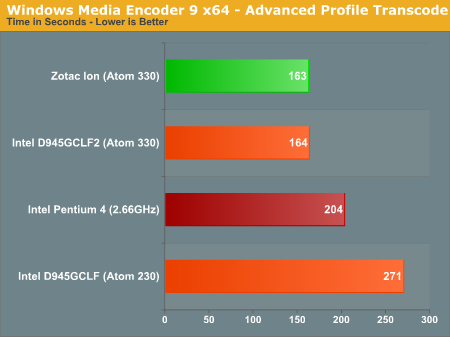
Again, the Atom 330 is faster than the Pentium 4 and again it’s due to the extra core. The Atom 230 is noticeably slower.
x264 encode performance is even more embarrassing for the Pentium 4; the Atom 330 is 62% faster in the first pass and 94% faster in the 2nd pass of the encode. The P4 system was 15% faster than the Atom 230 in the first pass and around 5% faster in the second pass.
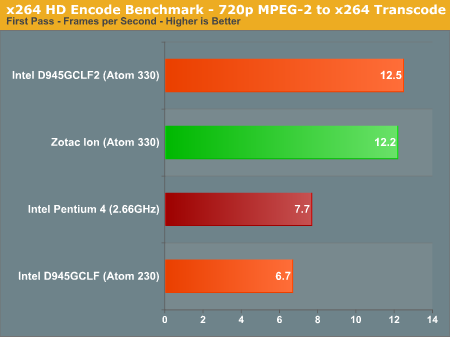
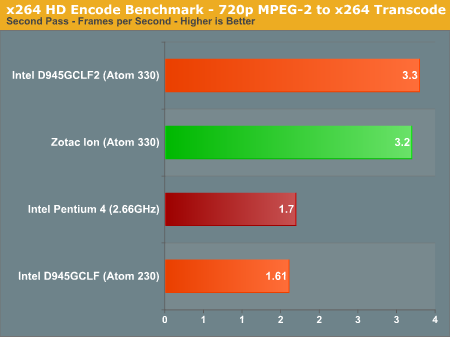
Next up was Cinebench. This is an interesting benchmark to look at because it offers both a single-threaded and multi-threaded benchmark. The Pentium 4 without Hyper-Threading can only execute a single thread, so the multi-threaded test can’t run. I’ve combined the meaningful results in a single chart:
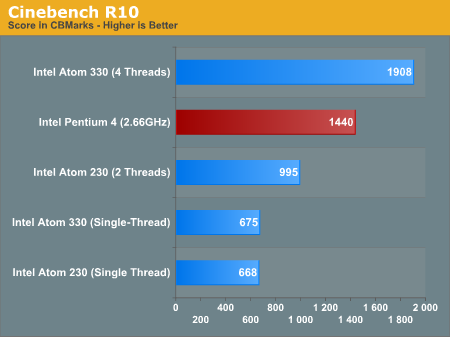
If we look at single-threaded performance, the Pentium 4 destroys the Atom - offering more than twice the performance of the svelte Atom core. Enable the multi-threaded render and the Atom 330 pulls ahead by 33%. This is the strength of the Atom; it’s clearly not faster than the Pentium 4 when working on a single thread, but exploit its ability to work on four threads simultaneously and it can actually be faster than a much larger, much more power hungry Pentium 4. This is a very important point to remember because despite losing to the Atom 330 in nearly all of the benchmarks, the Pentium 4 system it felt much faster than the Atom system in normal usage.
Simple things like opening up Control Panel or switching between windows felt faster on the old Pentium 4 system, which makes sense given that those tasks only spawn a single thread. In Cinebench we saw that the single-threaded performance of the old Pentium 4 was over twice as fast as the Atom - you tend to notice performance differences of that magnitude.
The final application test I ran was our WinRAR compression benchmark:
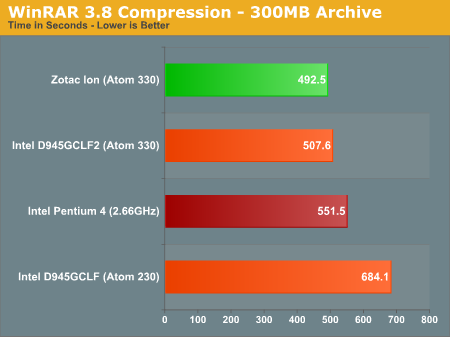
Once more, the Pentium 4 gets beat by the Atom 330 but turns the tables on the Atom 230. Even file compression is multi-threaded these days, and that is the Atom’s saving grace.
I wanted to know how well the GeForce 9300 could stand up against the old Dell’s Radeon X800 XT so I ran my WoW test on both systems. This is less of a CPU test and more of a CPU + GPU test obviously, but the results are interesting:
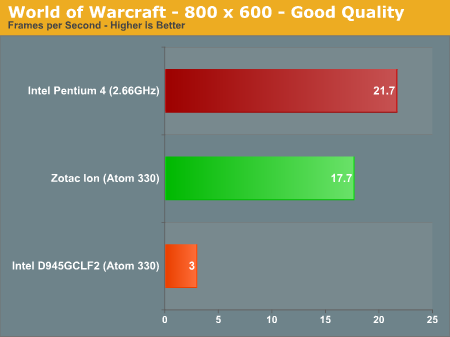
The Pentium 4 + X800 XT system is clearly faster, but not by as much as I expected. The advantage amounts to 22.5%, which is very noticeable, but close enough that if you had an even older system (or one with a lesser video card) you might not notice the performance difference between it and the Zotac Ion.
The last benchmark I ran comparing the Atom to a Pentium 4 was Futuremark’s Peacekeeper - a benchmark for measuring web browser performance. The benchmark is unaffected by internet connection and simply measures, once loaded, how fast your PC can work with various forms of commonly used javascript. I ran all of the Peacekeeper tests using Google Chrome:
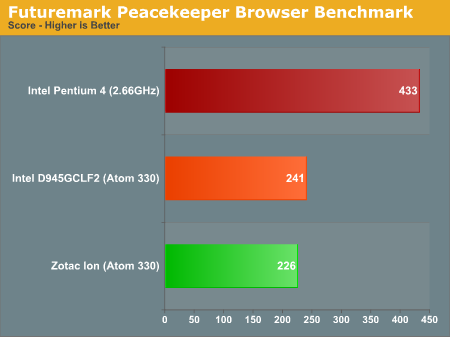
The Pentium 4 absolutely demolished the Atom here. Once again it’s almost twice as fast as the Atom 330. In a multi-threaded environment the Atom 330 can pull ahead, but in most typical day-to-day tasks the Pentium 4 is going to be a much faster solution.
Power efficiency is obviously where the Atom based Zotac Ion wins out. AMD and Intel both viewed the move to multiple cores as a performance and power efficiency win, and the results below help show that. Granted Atom is built on a 45nm process and we’re looking at a 130nm desktop Pentium 4 system, which is where much of the difference really comes from. But the results do show you that if you don’t need top bin performance you can build a very capable PC these days with significantly better power consumption characteristics.

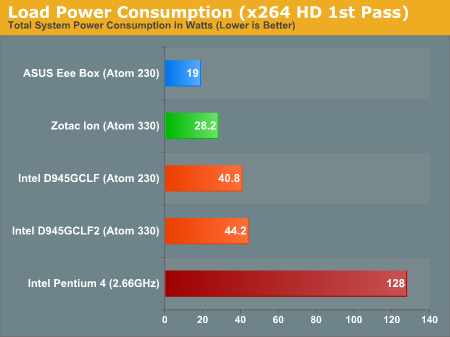
NVIDIA is forever arguing with me about how Atom and its Ion platform is a significant upgrade to PCs that are a few years old. My Pentium 4 results show that unfortunately, that’s not exactly the case. The Pentium 4 system I compared Zotac’s Ion to could never function as a modern-day HTPC and it won’t play Blu-ray discs. In those senses, Zotac’s Ion would be a tremendous upgrade. Even in multi-threaded CPU bound scenarios such as video encoding or 3D rendering, a dual-core Atom 330 is appreciably faster than the old Pentium 4 based Dell system. However, in normal web browsing and simply interacting with Windows, the Pentium 4 is significantly faster. The benchmarks show a nearly 2x performance advantage in single-threaded applications and I’d say they are accurately reflected in the usage experience.










93 Comments
View All Comments
gochichi - Tuesday, June 2, 2009 - link
The board is cool as could be. And also, the external power brick is precisely what is needed to make this thing relevant.I've always had a dream to build my old computer case, to build a computer that was unique in its size and look. I'm a pretty good wood worker, and I can cast simple aluminum shapes... you get where I'm going with this.
So this obviously is the dream motherboard for that application. Making some awesome looking little computer out maple or something.
It also hits the mark with the silent or near silent design. You add a laptop hard drive for its quiet operation and you're in business.
I am impressed, and as an enthusiast it hits the marks. The problem is that I'm more of an enthusiast in my mind than in my purchases. I snap out of the trance and realize that for the price of the motherboard you can have a complete computer w/ a case and a warranty with a 2.2ghz core-based single core Celeron which would just about trounce this little fellow. It's not quiet and it's not tiny but I'm a looser like that. I just can't do it.
Then again, I don't have a ton of extra cash. I can think of a million things I'd rather do with $400.00 than build a swanky looking (and silent) PC with this platform.
This platform is ripe for the picking. It's cheap to make, and it fills a need. We need to start seeing these out in the stores in volume. Because at the end of the day, these computers could be small enough that you don't even see them. Ubuntu is also ripe for the picking (Microsoft is fine, just too expensive for these little machines IMHO).
It is absolutely possible, to make a desirable machine out of this with 2GB of RAM and an 80+ GB hard drive for the sub $200 range. I can find some pictures of Acer's computer, but I haven't seen it at Walmart... so really, it hasn't been released yet. These products are profitable and cheap, why aren't companies making them?
Hrel - Wednesday, May 27, 2009 - link
Seems to me this article shows you wasted money, and could have easily gotten away with putting an E5300 in your HTPC, or similar, and saved what? 300 dollars. Yeah, Q9650 still costs WAY too much to be a viable option, and for most uses is overkill anyway, especially for an HTPC.piasabird - Sunday, May 24, 2009 - link
How would this compare to an Intel 1.4 Gig Celeron? I have an Intel 1.2 gig Celeron and it still runs and it runs fairly cool with a lower end power supply. This is the Celeron based on the PIII. Is the Atom processor more advanced that that?ozonarium - Tuesday, May 19, 2009 - link
Why these things do not have a video input for video recording? Or I'm missing something. Thanks.Guspaz - Sunday, May 17, 2009 - link
You'll probably get better results from CoreAVC for h.264 playback (compared to MPC-HC's DXVA codec) for at least two reasons:1) CoreAVC is far better multithreaded than libavcodec, which MPC-HC's decoder ultimately relies on. It makes 720p h.264 generally playable on an Atom 230 even without any acceleration, and the 330 should have no issues
2) CoreAVC recently added CUDA support, which includes the 9300 used in the Ion.
I also recommend combining it with Haali's Renderer (comes with Haali's Splitter) and giving it a chunk of RAM for the buffer. It will buffer uncompressed frames/audio and help smooth over any spikes in CPU usage.
mode101wpb - Thursday, May 14, 2009 - link
I have been eyeing this one up since I knew about it. I recently built the MSI Wind PC barebones nettop single core 230 Atom. It handles 720p fine if it's not streaming, albeit the processor is loaded 90%, 1080p is not possible on the 945GC.The Ion will smooth over some of the issues nicely, as well the Zotac board supports up to 4GB of ram, the MSI Wind PC nettop maxes out at 2GB, though it supports x64 there isn't enough Ram available to make good use of it. The Zotac has the same processor (230) so x64 is not an issue either. DVI is nice as is the power brick.
Newegg has two 230 mobos in stock, $149 w/o the 90w brick, and $169 with it. Not cheap, figure in $50 for 4GB of Ram, optical drive (blue ray $$$ or dvd), hdd and a case it's easily a $300-600 build for the single core 230. No pricing on the 330 yet, but I suspect it will be over $200.
I would opt for the dual core for better performance, albeit heat and energy savings will be sacrificed. Still have to wonder justification on this, the Atom has limitations and there will be a bottleneck for sure.
nubie - Thursday, May 14, 2009 - link
It's only $139 for a socket 775 version.The Celeron 420/430/440 are much more powerful than an Atom. Even if you underclock them a little.
If you need "power brick" power investigate the PicoPSU: http://www.mini-box.com/DC-DC">http://www.mini-box.com/DC-DC
I am sure if you want a proper mini PC you could build one on 775 (don't forget that there are 45nm processors and you can use a copper core heatsink, even a $10 OEM one from the older 65nm Quad cores will keep it running very cool).
I would love to see the power usage back-to-back with a PicoPSU between the "Ion" and the LGA 775 platform (please choose a low-end proc like Cel 1400/1500 or e5200, and throw in a Celeron 420-440 as well). I would expect it to be 10-15 watts more, but with much more processing power.
monomer - Thursday, May 14, 2009 - link
A few weeks ago, Anand posted an article regarding Blu-Ray playback performance issues with the Ion chipset, which was quickly taken down after Nvidia wanted time to replicate the results. Whatever happened with this? Was there some type of workaround used to fix the Blu-ray playback?strikeback03 - Thursday, May 14, 2009 - link
On page 3:"Earlier versions of PowerDVD were not well optimized for Atom, but the latest updates to PowerDVD 8 and PowerDVD 9 ensure smooth playback on even a single-core Atom/Ion system (I used an older version of PowerDVD in my short lived Ion Blu-ray Investigation which was the cause for poor performance in those tests)"
OSdeveloper - Thursday, May 14, 2009 - link
Since most people are using Windows XP, and especially since XP is more likely to be used on Atom based computers, it would be more meaningful to run benchmarks with XP rather than Vista. Other than that, it was a very interesting read. Good job Anand!